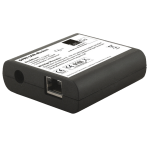ConiuGo LAN modem
ConiuGo is a German manufacturer of industrial GSM modems and wireless data equipment. Their range of GSM modems include models with a serial port, USB port and RJ45 LAN port. There are also separate models with DIN-rail casing and UMTS wireless modules.
There are not a lot of simple GSM LAN modems on the market that are suitable to send and receive SMS messages. And since LAN modems are ideal for use in computer rooms, data centers and with virtual computers, we decided to try out the quad band ConiuGo GPRS modem with the RJ45 LAN port.
| ConiuGo LAN modem specifications | |
|---|---|
| Connection | RJ45 Ethernet (TCP/IP) |
| GSM Frequency bands | 850, 900, 1800, 1900 |
| Network protocols | GSM, GPRS |

ConiuGo LAN modem
The ConiuGo LAN modem, plus external power supply and antenna, was bought from the ConiuGo reseller Conrad. The modem is sold without antenna and power supply and the antenna kit that we ordered with the modem required soldering a micro antenna to a small circuit board. Ordering another antenna with the modem that already has an MMCX connection is probably a better option.
Setting up the ConiuGo LAN modem
Installing the ConiuGo LAN modem is pretty straightforward. The device was shipped with fixed IP number 192.168.0.19 and, after inserting the SIM card and connecting the power supply, antenna and LAN cable, it was immediately available on our LAN network. For networks with another IP range, the network settings can be changed in the web interface of the modem.
Important: In the 'Connection' settings of the ConiuGo LAN modem, the 'Telnet Com Port Cntrl' property must be set to 'Disable'. If this property is set to 'Enable', Diafaan SMS Server won't be able to communicate with the modem.
The AT command set of the modem is available on TCP/IP port 10001. The CD that was supplied with the modem contains a virtual COM port driver for the modem but since Diafaan SMS Server can use the IP connection of the modem directly, it is not necessary to install it. The modem was detected without problems by Diafaan SMS Server, it identified itself as a Motorola G24 GSM modem module but newer models of the ConiuGo modems use Telit modules.
In the web interface of the ConiuGo LAN modem it is possible to change the settings for the serial port, modem and network. The web interface is easy to use and for use with Diafaan SMS Server all options can be left on the default values. If the settings are changed, you can use the 'Apply Defaults' option to set the modem back to the factory settings.

ConiuGo DIN-rail LAN modem
Daily operation
The ConiuGo LAN modem performed well in our tests, all SMS features are supported including USSD and delivery reports for sent SMS messages. The only problem we found is that the Motorola G24 GSM chip has a problem with alphanumeric originator addresses for received SMS messages. The message is received OK but the originator address is mangled. This is usually not a problem but it might make it more difficult to filter out service messages that are sent by the GSM operator.
The modem supports the full reboot command from Diafaan SMS Server after GSM modem encounters a problem. It also recovers well after the network connection has temporarily been down, this makes the ConiuGo LAN modem a reliable SMS modem for Diafaan SMS Server.
SMS send speed
| Network | Vodafone |
| Signal quality | Average |
| Time to send 500 messages of 160 characters, delivery confirmation enabled. All messages sent to the same number (concurrent send and receive) | 1 hour 4 minutes 9 seconds |
Conclusion
The ConiuGo LAN modem is an excellent GSM modem for use in industrial environments and LAN networks. ConiuGo modems are relatively expensive but the LAN module makes it a very useful GSM modem in combination with Diafaan SMS Server, specially in situations where a serial port- or USB GSM modem is impractical, for instance when Diafaan SMS Server is installed on a virtual computer.
